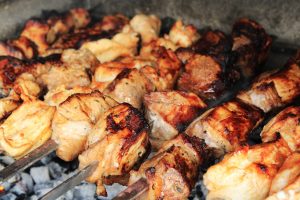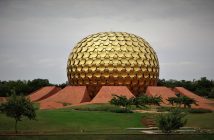Did you know that when Krishivan was in its initial stages of being designed, its name was proposed to be Vrindavan? Like the Tulsi Vrindavan, the structure for enclosing what’s considered the sacred tulsi plant. And why? Because the farm is embraced by green foliage of which tulsi is a part. Plants are known to emit oxygen but of all plants, the tulsi is known to emit the highest amount of oxygen per square inch of foliage/leaf surface area. That is why, in the ancient days when the woman was confined to the “mula” and “chula“, she made it a point to take those daily all-important puja rounds around the tulsi plant. She gained a chance to inhale fresh oxygen to make up for its loss in her “chul ani mul” routine with little scope to breathe fresh air.
While on the topic of plants, allow me to introduce you to the plantation area on the farm. Close to the entrance, there are cabbage and moong seeds planted in alternate patches.

Sprouting dicots
Green moong is nothing but dal dicots which use nitrogen fixtures to abet its growth. They develop in the ground, and with the atmospheric nitrogen being over 70% which is of not much use to the hoi polloi, it gets its much-needed “fix”. The plants capture this nitrogen and fix it in the root nodules. With the aid of special kinds of bacteria called Rozibium and Azictomacta, the nitrogen is fixed and made available to the plant in the format that is easily absorbed by it.
As the cabbage growth span is 45 days or so, it is planted first. This is followed by moong seeds whose span is 70 to 75 days. It is easier to harvest the vegetables in separate lots than at all at once, rendering a gap of 30 days between the two vegetative patches. More often than not, moong generates more waste than not. This is used as mulch, a description of which you may have seen in the previous article.

Cherries
As far as berries go, the harvesting process is divergent from the regular. Nitrogen and potassium foster growth in the roots while phosphorus to the fruit growth. An eye needs to be trained on the berry plants, as when a single berry turns red, the entire plant needs to be harvested without delay. The berries are subsequently removed from the main stem and bundled together for further marketing/distribution or processing into preserves.

Waste, which is recycled in a process called pyrolysis
As it had turned a wee dark by the end of the plantation area, we made our way back to the main farm but stopped by to check the process of plastic recycling. As common to most tourists, there are leftover cans or bottles or tissues and whatnot. The common solution for garbage disposal is to burn it, including plastic refuse. Plastic is pyrolysed, which in simple terms means burning of plastic in insufficient air at high temperatures till liquefied. The liquid can be used in engines and generators but on the farm, is used in kerosene pumps. The bathwater comes hot through these large kerosene pumps fitted on the farm.
A by-product of plastic burning comes in the form of charcoal, a pure carbon piece. Isn’t it intriguing how they let not waste go to waste!

Charcoal
As if this alone is not sufficient to hold one’s interest, the charcoal waste is further put to use in barbecues. Imagine having a chicken barbecue on carbon that’s a by-product of the plastic waste left behind by you or a fellow tourist! That there are several other uses of charcoal is common knowledge and need not be elucidated.
This was our last night on the farm, and so we preferred to enjoy a barbecue and sip on coolers. At night would come the quintessential Maharashtrian dinner comprising “kombdi cha kadi“. We knew that they had obtained a large chicken for the barbecue to make it easier to be skewered and that the rest would certainly have gone into a curried chicken.

Barbecue on coals
If you aren’t fussy about a premium stay, this place will take you on a happy scientific expedition in a simple-no-frills manner. And with oh what wealth of information too






2 Comments
Have you ever thought about adding a little bit more than just
your articles? I mean, what you say is valuable and all. Nevertheless think about if you added some great photos or videos to give your posts more,
“pop”! Your content is excellent but with pics and videos, this blog could undeniably be one of the greatest in its niche.
Great blog!
Yes, thanks I have thought about high definition images. Am going that way soon.